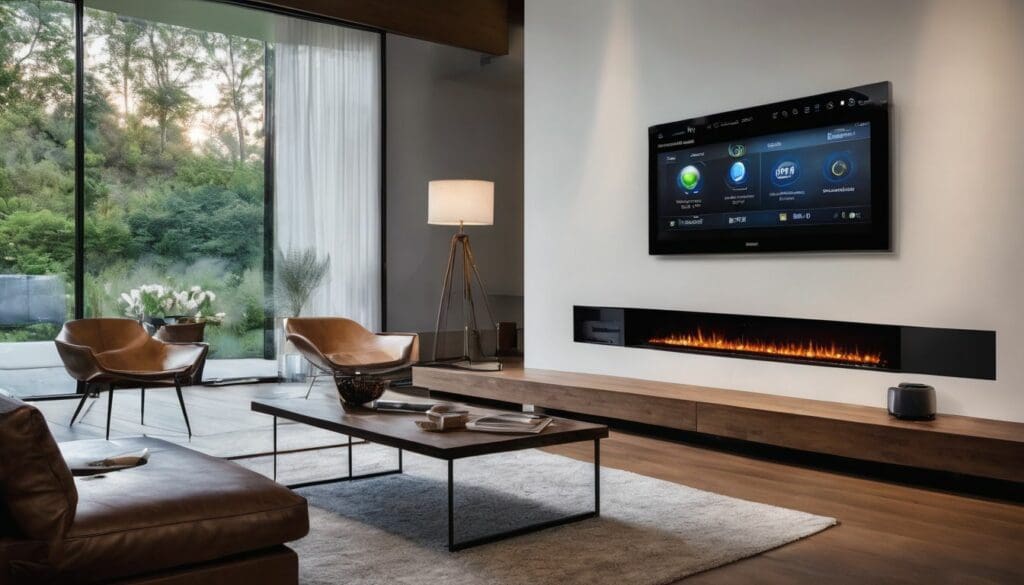Are your energy bills climbing higher each month? Recent studies show that households could save up to 30% on their energy costs with effective monitoring. Our blog takes you through the ins and outs of Home Energy Monitoring Systems (HEMS), equipping you with the knowledge to cut costs and boost efficiency in your home.
Discover smart living today!
Key Takeaways
- Home Energy Monitoring Systems (HEMS) allow homeowners to track and manage their energy use in real time, leading to potential savings of up to 30% on energy bills.
- Smart devices such as meters, sensors, and intelligent HVAC controllers work with software platforms for easy monitoring, contributing to more sustainable living by reducing unnecessary energy consumption.
- Latest HEMS trends include the integration with smart home technologies and the implementation of artificial intelligence which learns patterns and automates settings for enhanced efficiency.
- These systems are not only gaining popularity in homes but are also expanding into commercial and industrial sectors due to their benefits in cost savings and environmental impact reduction.
- By embracing HEMS technology, individuals can enjoy a more comfortable living environment while actively participating in eco-friendly practices.
What are Home Energy Monitoring Systems (HEMS)?
Home Energy Monitoring Systems (HEMS) are smart devices and software that allow homeowners to track, monitor, and manage their energy usage in real-time. These systems typically consist of hardware such as smart meters and sensors, along with corresponding mobile apps or web platforms for user interface.
Definition and purpose
Energy Monitoring Systems (HEMS) are innovative tools that track electricity usage in real-time, offering a detailed look at where and how energy flows through a home. They serve a crucial role in promoting sustainable living by empowering homeowners with the information needed to make smarter energy choices.
By identifying which appliances or systems consume the most power, these devices foster more than just awareness; they facilitate substantial reductions in unnecessary energy consumption.
The purpose of HEMS aligns closely with environmental conservation efforts as well as the desire for enhanced energy management within households. These systems enable residents to engage actively with their daily energy habits, leading to more eco-friendly homes and sizable savings on utility bills.
Moreover, integrating these monitoring solutions into smart home technology further optimises resource use by automating and refining the way we interact with our domestic environments for peak efficiency and comfort.
Components (hardware and software)
Home Energy Monitoring Systems (HEMS) consist of various components, including hardware and software. These components work together to monitor and manage energy consumption in households. The hardware typically includes smart meters, sensors, and control devices, while the software comprises data analytics platforms and user interfaces. Here are the main components of a HEMS:
- Smart Meters: These devices measure electricity usage in real-time and provide detailed insights into energy consumption patterns.
- Sensors: These are used to monitor the use of electricity, water, and gas throughout the home, helping users identify areas for potential energy savings.
- Control Devices: These allow users to remotely adjust lighting, heating, cooling, and other energy-consuming systems in their homes.
Types of HEMS
From lighting controls to advanced central controllers, there are various types of Home Energy Monitoring Systems available. Each type serves a specific purpose in helping homeowners monitor and manage their energy usage efficiently.
Lighting controls
Lighting controls in home energy monitoring systems allow users to adjust and manage their lighting usage, promoting energy efficiency. These controls enable the scheduling and dimming of lights, reducing unnecessary consumption.
By integrating smart lighting technologies, such as LED bulbs and motion sensors, households can further optimise their energy use and contribute to sustainable living practices.
Implementing lighting controls aligns with the goal of minimising environmental impact by curbing excessive energy wastage. Additionally, it fosters a greener lifestyle while upholding the principles of eco-friendly living and renewable energy adoption for environmentally conscious individuals seeking to reduce their carbon footprint.
Self-monitoring systems and services
Domestic users can benefit from self-monitoring systems and services, which enable them to track their energy usage. These systems provide real-time data on electricity consumption, helping homeowners identify areas for potential savings and adjust their habits accordingly.
Through the use of smart meters and energy monitoring devices, individuals have the opportunity to actively manage their household energy consumption, contributing to a more sustainable lifestyle while reducing utility costs.
Integrating self-monitoring systems with other smart home technologies allows for seamless control over energy usage throughout the house. With these advanced solutions, environmentally conscious individuals can take proactive steps towards eco-friendly living by effectively managing their residential energy consumption.
Programmable communicating thermostats
Programmable communicating thermostats, often referred to as PCTs, are an essential component of home energy monitoring systems. These intelligent devices allow homeowners to remotely control and schedule their heating and cooling settings, optimising energy usage and reducing utility costs.
PCTs integrate seamlessly with smart home technology, providing real-time data on energy consumption and enabling users to make informed decisions about their usage. By using these advanced thermostats, households can achieve significant energy savings without compromising comfort or convenience.
PCTs form part of a wider trend towards eco-friendly living and sustainable homes by promoting greater awareness of energy use in domestic settings. Through the integration of programmable communicating thermostats into household energy management systems, individuals can take proactive steps towards reducing their environmental impact while enjoying the benefits of increased cost-efficiency and improved comfort within their homes.
Advanced central controllers
Advanced central controllers are a key component of home energy monitoring systems, allowing for centralised control and management of various energy-consuming devices. These controllers enable users to monitor and adjust the settings of their lighting, heating, ventilation, and air conditioning (HVAC) systems from a single interface.
This seamless integration provides homeowners with greater flexibility in optimising energy usage and maximising efficiency, leading to reduced electricity consumption and lower utility bills.
These controllers also offer advanced scheduling features that can automatically adjust energy settings based on occupancy patterns or time-of-day preferences. By harnessing this technology, individuals can significantly enhance their eco-friendly living efforts while contributing to overall conservation aims.
Intelligent HVAC controllers
Intelligent HVAC controllers use smart technology to optimise heating, ventilation, and air conditioning systems. These controllers monitor indoor and outdoor conditions, adjusting temperatures and airflow for maximum efficiency.
By integrating with energy monitoring systems, they help reduce overall energy consumption. Using AI algorithms, these controllers can learn usage patterns to adapt settings automatically.
By using intelligent HVAC controllers within a home energy monitoring system, users can enjoy improved comfort while reducing their carbon footprint and utility bills. With remote access features, homeowners can easily manage their HVAC systems from anywhere at any time for sustainable living.
Benefits of HEMS
HEMS offer increased energy efficiency and cost savings, as well as the convenience of remote monitoring and control, ultimately leading to improved home comfort.
Increased energy efficiency
Home energy monitoring systems (HEMS) play a pivotal role in enhancing energy efficiency within households. With the ability to track and monitor energy usage, HEMS empowers homeowners to make informed decisions about their energy consumption.
By identifying areas of high energy usage, individuals can adjust their habits and implement changes that lead to reduced energy wastage and overall lower utility bills. Integrating smart grid technology with HEMS allows for real-time analysis of home energy use, giving users actionable insights into how they can optimise their consumption.
Incorporating domestic energy management systems not only benefits individual households but also contributes positively to the environment through reduced carbon emissions and lesser strain on natural resources.
Cost savings
Home energy monitoring systems contribute to significant cost savings by providing insights into household energy usage. By identifying areas of high consumption, households can adjust their habits and implement energy-saving measures, leading to reduced utility bills and long-term financial benefits.
These systems also enable users to monitor real-time energy usage data remotely, allowing for immediate adjustments that lead to savings on electricity costs.
Furthermore, the integration of smart home technology with energy monitoring systems allows for automated control of appliances during off-peak hours when electricity rates are lower, resulting in additional cost savings.
Remote monitoring and control
HEMS technology allows for remote monitoring and control of home energy usage. Through a user-friendly interface, homeowners can access real-time data on their energy consumption and make adjustments to improve efficiency.
This feature provides the ability to remotely manage lighting, heating, cooling, and other connected devices in line with individual preferences and schedules. Additionally, it enables users to monitor their energy usage from any location using a smartphone or web-based application.
The integration of remote monitoring and control capabilities in HEMS empowers environmentally conscious individuals to actively manage their energy consumption while promoting conservation efforts.
Improved home comfort
Enhance your home comfort with energy monitoring systems that optimise heating, cooling, and lighting for a more pleasant living environment. Smart metering technology enables you to adjust temperature settings remotely, ensuring comfortable indoor conditions while reducing energy waste.
By integrating intelligent HVAC controllers into your home energy management system, you can effortlessly maintain an eco-friendly and comfortable atmosphere, preserving natural resources without sacrificing comfort.
Latest Trends in HEMS
The latest trends in HEMS include integration with smart home technology, use of artificial intelligence, and expansion into commercial and industrial sectors. Stay ahead of the curve by reading more about these exciting developments!
Integration with smart home technology
Smart home technology integration allows for seamless control and monitoring of household energy usage. Smart thermostats, lighting systems, and appliances can be connected to a central HEMS, enabling users to adjust settings remotely using a smartphone or voice commands.
This integration optimises energy consumption based on real-time data, contributing to overall efficiency and cost savings. By integrating HEMS with smart home technology, individuals can actively participate in eco-friendly living by effectively managing their energy footprint.
Furthermore, the use of artificial intelligence in conjunction with smart home technology enhances the capabilities of HEMS. AI algorithms analyse patterns of energy consumption and make predictive adjustments to optimise usage.
Use of artificial intelligence
Home energy monitoring systems are increasingly integrating artificial intelligence (AI) to provide more advanced and efficient solutions for managing energy consumption. AI algorithms enable HEMS to learn household patterns, adjust settings automatically, and optimise energy usage in real time without manual intervention.
This results in improved energy efficiency, reduced costs, and a seamless experience for environmentally conscious individuals looking to support conservation efforts in their homes.
As part of the latest trends in home energy monitoring systems, the incorporation of AI allows for predictive analysis of energy usage data, enhancing the precision of recommendations and automated adjustments.
Expansion into commercial and industrial sectors
Having seen the use of artificial intelligence in home energy monitoring systems, it’s now clear that these technologies are also expanding into commercial and industrial sectors. Businesses and industries are adopting smart energy management solutions to improve efficiency, reduce costs, and enhance sustainability.
Smart metering for energy consumption is being embraced by companies seeking eco-friendly ways to monitor and optimise their energy usage.
Furthermore, commercial buildings are integrating energy efficiency monitoring solutions to track and manage power consumption, contributing towards a more sustainable environment.
Conclusion
In conclusion, home energy monitoring systems are becoming increasingly popular among environmentally conscious individuals. They offer a range of benefits including increased energy efficiency and cost savings.
The latest trends show integration with smart home technology and the use of artificial intelligence, pointing towards a promising future for these innovative systems. As more people embrace eco-friendly living, the demand for home energy monitoring systems is expected to continue growing in the residential, commercial, and industrial sectors.
FAQs
1. What are home energy monitoring systems?
Home energy monitoring systems are smart devices that track and report your household’s energy usage, helping you manage electricity consumption more efficiently.
2. Why is it important to monitor my home’s energy use?
Monitoring your home’s energy use with a residential energy management system can help you cut down on waste, save money, and live an eco-friendly lifestyle.
3. How do smart metering devices work in the home?
Smart metering for home energy lets you see real-time data about how much power each appliance uses so you can make better decisions about saving electricity in your house.
4. Can installing an energy consumption monitoring device really make my home smarter?
Yes, using a smart home energy monitoring technology gives you control over your electric bills by allowing precise tracking of when and where your residence consumes the most power.





